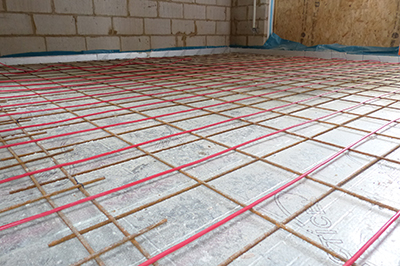We use cookies to deliver you the best experience of LUCKINSlive according to our privacy policy which explains what cookies are and how we use them.
By closing this message, we'll assume that you are happy with our use of cookies on this device.
Date Installed: July 2014
Location: West Sussex
Client: Mr and Mrs Whitbread
System specifications:
Heat Mat was approached to specify and oversee the installation of electric underfloor heating for an extension at a period property in Sussex. The property is not on mains gas, and an energy efficient electric system was required as the sole source of heating. To ensure no additional build height was added and keep walls free from obstructions, Heat Mat’s In-Screed cable system was installed in the dining room and 200W heating mats in the wet room.
The goal:
The owners of this idyllic rural home were successful in being granted planning permission for a new extension adjacent to their character property, but how to heat it was posing a challenge.
The homeowners wanted to utilise all of their wall space and prevent restrictions to the layout of their furniture, so panel heaters were not suitable. It was important keep the purchase and installation costs down and to ensure minimal disruption occurred to the on-going building work.
The owners also intended to install a photovoltaic (PV) system on the extension in the future, therefore it would be beneficial if the final heating system could take advantage of on-site generated 'free' electricity. They consulted their chosen contractors, Arun Builders, who recommended Heat Mat. As the property is in an area without mains gas, a wet system wasn’t an option, and would have been far more expensive to install. Heat Mat’s technical team were approached to specify an energy efficient electric heating system for the new build extension.

The Solution:
In the wet room it was important to have a fast reacting system to rapidly heat the space. The room is not the primary bathroom and will be used irregularly therefore daily heating is not required. In the dining room the requirement was for a sole source of heating to be installed, allowing the family to regularly eat and entertain guests in the room.
Technical experts from Heat Mat surveyed the extension and worked with the builders to design a solution suited to the power available on site while maintaining the aesthetic integrity of the building. Heat Mat's solution was to provide their low cost and fast-to-fit 6mm Red in-screed heating cable in the dining room, controlled by an intelligent NGT thermostat/timer.
The 6mm Red heating cable was cable-tied directly onto reinforcement fabric ensuring a speedy installation. The screed bed above the heating cable could then be charged up with heat and would provide a very stable temperature in the room.
In the wet room area Heat Mat specified their fast reacting 200W/sqm heating mat system and recommended this be installed directly onto 10mm thermal insulation boards to speed up the warm-up time and maximise energy efficiency.
The result:
Electric underfloor heating was the ideal choice, especially in this off-gas location. Installing one of Heat Mat’s high-quality electric underfloor heating systems ensured no additional build height was added and the process was efficient and cost-effective - on this site the specified products were fitted in less than half a day with Heat Mat’s technical team on hand to supervise.
The result is a beautifully warm dining room, which can be furnished as desired without having to work around radiators or panel heaters. In the wet room area the heating responds rapidly, achieving a warm room and floor in less than 30 minutes.
As an additional benefit once the PV system is installed it will be capable of powering the heating system using 'free' on-site generated electricity. This electricity will charge up the screed bed during the day, releasing heat at night when it is most needed.
The homeowner was amazed at how quickly the 6mm heating cable was installed. We would recommend a team of two people fitting the system if possible, although it can be fitted by a single installer, it is far simpler to fit with two people working at each end of the room. It makes installing onto fixing strip or reinforcement fabric seem like a more manageable task!
We use cookies to deliver you the best experience of LUCKINSlive according to our privacy policy which explains what cookies are and how we use them.
By closing this message, we'll assume that you are happy with our use of cookies on this device.

 Search is in progress, please be patient...
Search is in progress, please be patient...

 Searching ALL product data, this can take a while please be patient...
Searching ALL product data, this can take a while please be patient...


